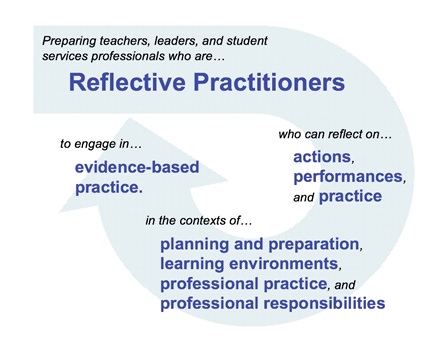Since the School of Education's founding in 2003 at the University of Wisconsin-Stout, its mission has been to engage in exemplary teaching, research, and service to ensure that graduates become successful professional educators in PK-12 settings. Further, the School of Education's vision is to prepare teachers and other professional educators who are reflective practitioners and engage in evidence-based practice.

The process of becoming a reflective practitioner follows a framework for teaching that includes: a) planning and preparation, b) classroom environment, c) instruction and d) professional responsibilities (Danielson, 1996). These four domains are aligned to the Wisconsin Standards for Teacher Development and Licensure and contain necessary and specific components that are assessed at multiple stages throughout each student's teacher education preparation program.
InTASC / Wisconsin Teacher Standards Standards Linked to Danielson Framework
InTASC Standard |
Danielson Framework Component(s) |
THE LEARNER AND LEARNING |
|
#1 Learner DevelopmentThe teacher understands how learners grow and develop, recognizing that patterns of learning and development vary individually within and across the cognitive, linguistic, social, emotional, and physical areas, and designs and implements developmentally appropriate and challenging learning experiences. |
Planning and Preparation1b: Demonstrating Knowledge of Students 1c: Setting Instructional Outcomes 1e: Designing Coherent instruction |
#2. Learning DifferencesThe teacher uses understanding of individual diverse cultures and communities to ensure inclusive learning environments that enable each learner to meet high standards. |
Planning and Preparation1b: Demonstrating Knowledge of Students |
#3: Learning EnvironmentThe teacher works with others to create environments that support individual and collaborative learning, and that encourage positive social interaction, active engagement in learning, and self-motivation. |
Classroom Environment2a: Creating an Environment of Respect and Rapport Instruction3c: Engaging Students in Learning |
CONTENT |
|
#4: Content KnowledgeThe teacher understands the central concepts, tools of inquiry, and structures of the discipline(s) he or she teaches and creates learning experiences that make these aspects of the discipline accessible and meaningful for learners to assure mastery of the content. |
Planning and Preparation1a: Demonstrating Knowledge of Content and Pedagogy 1e: Designing Coherent Instruction Instruction3c: Engaging Students in Learning |
#5: Application of ContentThe teacher understands how to connect concepts and use differing perspectives to engage learners in critical thinking, creativity, and collaborative problem solving related to authentic local and global issues. |
Instruction3a: Communicating with Students 3c: Engaging Students in Learning 3f: Demonstrating Flexibility and Responsiveness |
INSTRUCTIONAL PRACTICE |
|
#6: AssessmentThe teacher understands and uses multiple methods of assessment to engage learners in their own growth, to monitor learner progress, and to guide the teacher’s and learner’s decision making. |
Planning and Preparation1f: Designing Student Assessments Instruction3d: Using Assessment in Instruction |
#7: Planning for InstructionThe teacher plans instruction that supports every student in meeting rigorous learning goals by drawing upon knowledge of content areas, curriculum, cross-disciplinary skills, and pedagogy, as well as knowledge of learners and the community context. |
Planning and Preparation1b: Demonstrating Knowledge of Students 1e: Designing Coherent Instruction |
#8: Instructional StrategiesThe teacher understands and uses a variety of instructional strategies to encourage learners to develop deep understanding of content areas and their connections, and to build skills to apply knowledge in meaningful ways. |
Instruction3b: Using Questioning and Discussion Techniques 3c: Engaging Students in Learning |
PROFESSIONAL RESPONSIBILITY |
|
#9: Professional Learning and Ethical PracticeThe teacher engages in ongoing professional learning and uses evidence to continually evaluate his/her practice, particularly the effects of his/her choices and actions on others (learners, families, other professionals, and the community), and adapts practice to meet the needs of each learner |
Professional Responsibilities4a: Reflecting on Teaching 4e: Growing and Developing Professionally 4f: Showing Professionalism |
#10: Leadership and CollaborationThe teacher seeks appropriate leadership roles and opportunities to take responsibility for student learning, to collaborate with learners, families, colleagues, other school professionals, and community members to ensure learner growth, and to advance the profession. |
Professional Responsibilities4c: Communicating with Families 4d: Participating in a Professional Community 4f: Showing Professionalism |




